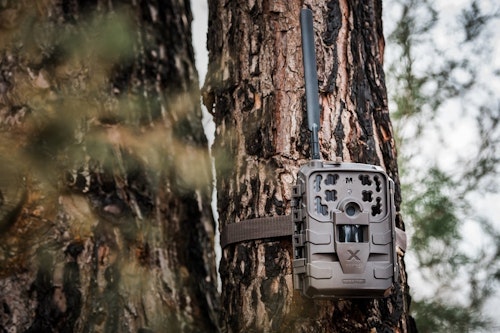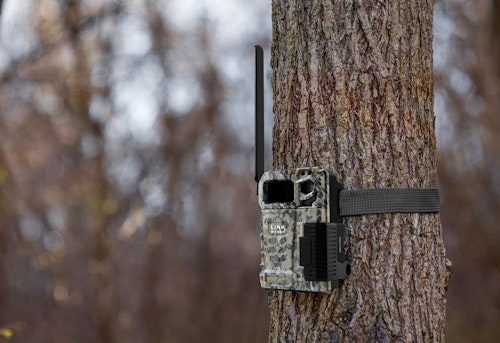I love the TV commercials from Progressive Insurance where therapist/life coach Dr. Rick points out the warning signs of new homeowners who are on the path to becoming their parents.
He leads off one of this seminars with the statement: “If you printed out directions on how to get here today, you’re in the right place.”
Fact: I regularly print out directions, and the same is true for airline boarding passes. Why? I assume technology will fail me, or stated more honestly, that I won’t be smart enough to use the tech as required. And I’m always worried my phone battery will die. With a paper map (and boarding passes), I have peace of mind.
During summer 2020, two companies — Moultrie Mobile and SpyPoint — invited me to field test their cellular trail cams. Initially, I said, “thanks but no thanks.” Why? Because I didn’t think in a million years I could figure out how to run the high-tech cell cam systems, and that’s exactly what I told the PR reps for both brands.
To their credit, however, these two Dr. Ricks didn’t give up. They both promised to answer every question I had, and believe me, I warned them I’d need hand-holding from beginning to end.
You’ve heard the saying: There’s no such thing as a stupid question. I told them I’d have plenty. And I warned them that just when they thought they’d heard the most ridiculous question ever asked about cellular trail cams, I’d top it, probably with my next one.


Old Dog, Meet New Tricks
The purpose of this article isn’t to dive into the specific features of the two cameras I used during late-summer, fall and winter 2020. Camera specs can change so fast that by the time I describe those details, they will likely be improved upon. In fact, the cell camera I field tested from Moultrie Mobile, the XV-6000, was sold out by Christmas 2020. Not only was it never back in stock, but now it’s been replaced by the new Moultrie Delta; MSRP of $99.99. The SpyPoint model I tested, the Link-Micro-LTE, is still offered; MSRP of $119.99.
Did you notice those low prices? The good news for hunters is even though camera technology continues to advance at breakneck speeds, competition in the marketplace is keeping prices in check. Many hunters can afford a few cell cameras today for the price of just one a few years ago. Nice.

You can visit the websites of both companies to learn about the many hunt-friendly features available in each camera. And of course, YouTube is an outstanding resource for learning how to properly position a trail cam for top-notch pics. (Hint: In the upper Midwest, I have the best luck aiming my trail cams north, away from the rising and setting sun, as well as the midday sun, which is in the southern sky.)
As I stated earlier, my biggest concern with accepting these two field tests was I didn’t want to spend hours in frustration trying to set up the cameras and coordinate everything with my phone. Thankfully, both companies provide tremendous support.
To get rolling with the SpyPoint Link-Micro-LTE, I watched a 3-minute YouTube video that described step by step what I needed to do to activate the cam. Click here to check it out. There’s also a video on how to choose and format a micro SD card (not included); check it out here.
Another YouTube tutorial I found very helpful when learning about the SpyPoint Link-Micro-LTE was uploaded by a retailer in Louisiana called Southern Boyz Outdoorz. The 8-minute video explains the packaging difference between a SpyPoint Link-Micro-LTE designed for Verizon vs. all other plans such as AT&T (called a nationwide plan by Moultrie). You want to buy the version that has the best coverage in your hunting area. (The cell plan used by your cam is independent of the one on your phone.) The video does a good job detailing the step-by-step process on how to get the camera ready to roll, as well as tips on how to choose certain functions such as camera sensitivity, delay, etc. I also learned a lot from watching this video from SpyPoint on using the app for managing cellular setup settings. It provides great advice on how to maximize battery life.
Moultrie Mobile also has a robust YouTube playlist of helpful how-to videos. As I said previously, the company’s new Delta cell cam replaces the XV-6000 I used in 2020. This 5-minute video explains how to activate the Moultrie Mobile Delta. The step-by-step instructions are easy to follow and should help anyone who wants to receive trail cam pics and videos on their phone.


Pricing Plans
The Moutrie Mobile Delta and SpyPoint Link-Micro-LTE are both affordable cameras. That said, to have the cams transmit pics to your phone, you’ll need a cellular plan for each trail camera you place in the field.
Moultrie Mobile has a YouTube video that clearly explains its current cellular plans and pricing. Check it out by clicking here. Plans begin at 100 images for $4.99 per month. Of course, depending on where your camera is placed and the number of deer (and squirrels and raccoons, etc.) in your area, you could quickly achieve that century mark. You can upgrade to 1,000 images for $9.99 per month, or 1,500 images for $14.99 per month, or unlimited images for $16.99 per month. Note: Depending on plan choice, you can save 10% to 40% if paid up front for the year.
If you don’t want to pay a dime for transmitted pics, then SpyPoint provides that option. As detailed here, you can receive up to 100 pics per month for free. If that’s not enough images, you can upgrade to 250 images for $5 per month, or 1,000 images for $10 per month, or unlimited images for $15 per month. Note: With SpyPoint, you can save up to 33% by paying annually instead of monthly, and more savings are available if you become a member of SpyPoint’s Insiders Club.
Many deer hunters run cameras during late summer to capture pics of velvet bucks, then continue through the fall and into winter. For example, if you owned one cellular cam, you could purchase a plan of 1,000 images per month for August, September, October, November and December (five months) for $10 per month (either Moultrie or SpyPoint). For $50 you’d see everything (1,000 pics per month) that happens in front of that camera every second of every day during that five-month period.
The number of images captured and transmitted varies greatly depending on your camera location, as well as your camera sensitivity settings. If you’re not careful clearing away branches and tall weeds that could move by wind in front of the camera lens, then you’ll get many pics of branches and tall weeds. This isn’t a big deal if you have a cell plan for 1,000 images per month, but if you’re trying to limit pics to 100 or 250 per month, you don’t want the camera to stop transmitting images halfway through the month because it’s already sent 100 or 250 pics of blowing branches.
As for camera sensitivity settings, you’ll have to experiment a bit. If a cam is set too sensitive, you’ll get more false triggers (i.e. no deer). The good news is you can quickly and easily change a cam’s sensitivity setting via the app.


Final Thoughts
One aspect of using cellular trail cams that isn’t discussed much is the fact you need cell service in your hunting area for these cameras to transmit pics to your phone. I placed my Moultrie Mobile XV-6000 cellular cam in eastern South Dakota, where my phone works okay — not great — with its Verizon cell plan. The good news is the camera did a good job transmitting pics to my phone throughout the late summer, fall and winter. I placed my SpyPoint Link-Micro-LTE (Verizon Data model) on the same property and it worked well, too.
I mention this because cell carriers other than Verizon don’t have good coverage in this part of South Dakota. Purchasing a cell cam with a nationwide DATA plan (not Verizon) probably wouldn’t work. The camera would still take photos and save them to its memory card, but it wouldn’t have the ability to transmit them to your phone. To see pics, you’d have to visit the camera in person and pull the card.
Because I’ve been running scouting cameras on this South Dakota property since the days of 35mm film cameras (late 1990s), I generally understand how deer use the land. I know that mature whitetail bucks typically don’t arrive into my river-bottom until mid-October, then they roam up and down the creek system throughout October and November looking for a hot doe. Depending on snow depth and available food, they might stay during December, or leave for better habitat.
In past years, I checked standard (non-cell) trail cams about every other week, and sometimes only once per month. Each year I was amazed at how many mature bucks suddenly appeared on the property during a 2- or 3-day period, on their feet during daylight hours. Then they’d disappear, only to reappear in another week to 10 days. With non-cell cams, I learned this info after the fact.
With cell cams, however, I had daily proof on my phone that the action was hot. (I had my cams set up to transmit images twice per day to conserve battery life.) Even though I live 3 hours from the property, I had the opportunity to quickly pack my hunting gear and hit the road to take advantage of the intel. And just as important, I didn’t have to hike into the property to visit a cam in person, likely spooking deer, to gather this information.
Dr. Rick ends this Progressive Insurance commercial saying, “We’re going to open a pdf; who’s next?” I’m the guy on the far right of the scene, who’s slowly backing away in fear with his hands in the air like he’s just met a gun-wielding thug in a back alley. During summer 2020, because of fear, I slowly backed away from offers to field test two cellular trail cams, but I’m glad I changed my mind. If you’re on the fence, I suggest you give it a shot. You won’t regret it.













